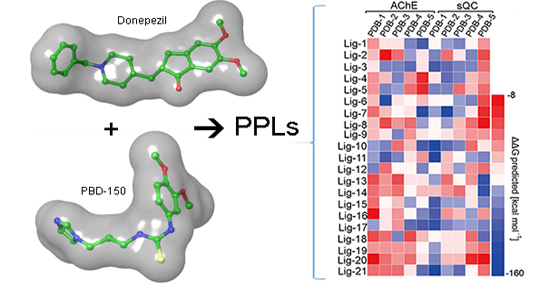research
Targeting Alzheimer’s disease in multimodal ways
The most common form of dementia, Alzheimer's disease (AD) is irreversibly debilitating and ultimately fatal, imposing a significant economic burden on society as a whole. AD exhibits multiple aetiological and pathogenic hallmarks. Although there have been significant advances in recent years, the need for effective AD is yet unmet. To overcome the setbacks and failures in AD drug discovery, researchers have been turning from monotherapy towards polypharmacological agents, which are better suited to address the multifaceted nature of the disease.

At LCSB, we are using machine learning design polypharmacological ligands against specific drug targets in AD (i.e. against acetylcholinesterase (AChE) and secretory glutaminyl cyclase (sQC). The AChE inhibitors prevent the hydrolysis of acetylcholine and uphold its level in the synaptic cleft. sQC is a rate limiting enzyme involved in the production of pyro-glutamine containing Aβ (pGlu-Aβ), which are highly neurotoxic and rapidly aggregating, so sQC inhibitors lower Aβ deposition in the brain, the primary causes of AD pathogenesis. Inhibiting AChE and sQC is a highly novel and very promising for the control of the AD pathology.

Spices are an underexplored source of lead molecules. Regular intake may provide more than flavor and also inhibit or even prevent neurodegenerative processes associated with aging and thus reduce the risk of neurodegenerative diseases such as Alzheimer's disease. Despite their common use, the mechanism of action of spice components at the molecular level is largely unknown. We are trying to isolate, purify, and characterize the binding potentials of their active chemical agents against the various drug targets involved in AD, e.g., monoamine oxidase, cyclin dependent kinase-5, Glycogen synthase kinase-3, and beta secretase. We are anticipating that identifying these chemicals may provide a new avenues to formulate novel therapeutic for AD.

Another source of inspiration are nootropics herbs. They are rich in antioxidants, neuroprotective, anti-amyloidogenic, and anti-inflammatory compounds that can modulate neuronal signaling and rejuvenate brain functions. In Aurveda there are tailored preparations known as ‘Medhya Rasayanas’, which can rejuvenate brain function and improve cognitive activities. Despite their widespread but specific use, the mode of action at the receptor level is largely unknown for these medications. We are employing a reverse pharmacological approach assisted with computational and structural biology to explore and characterize their effects against various drug targets in AD.

Understanding human prakriti through multidimensional approach
Prakriti is defined in Ayurveda as the unique health fingerprint of each person responsible for the homeostasis and metabolic activities in the human body. It encapsulates the physical, mental, and emotional features of a person. As prakriti is analyzed and determined by both objective and subjective parameters and there is no well-defined molecular basis, its determination may sometimes vary due to observational errors or discrepancies in estimation. We are trying to understand the phenotypic-genotypic correlation of prakriti through a multi-dimensional approach. Understanding Prakriti in a comprehensive way provides insight into pharmacogenomics and helps designing personalized Ayurveda medicine.
Tackling Uterine fibroids using rationally designed SPRMs
Uterine Fibroids (UF) is one of the major health burden for women worldwide. It largely affects the quality of women’s life. Management of UF mainly relies on surgical resection. Apart from this, various other strategies such as minimally invasive and non-invasive procedures were implemented for the control of UFs. The pharmacological management of UF with currently available medications mainly provide symptomatic reliefs by targeting hormone receptors that regulate heavy menstrual bleeding and pelvic pressure. Gonadotropin-releasing hormone (GnRH) receptor agonists and anti-progestins were used for the treatment of UFs, however, due to the adverse side effects they are not that promising for the treatments. Recently, ‘specific progesterone receptor modulators’ (SPRMs) has been emerged as an alternate and promising therapeutic agents for UF, endometriosis and breast cancer. The SPRMs acts on the progesterone receptor (PR) with mixed profiles of action, i.e. exhibits both agonistic and antagonistic actions in a tissue-specific manner. We are trying to develop the SPRMs through computational and structural biology approaches.



